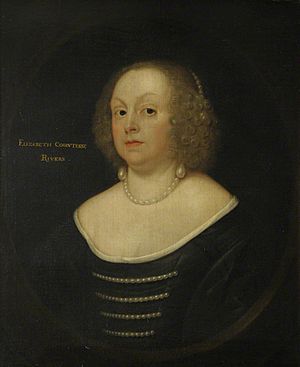Elizabeth Savage, Countess Rivers facts for kids
Quick facts for kids Elizabeth Savage |
|
|---|---|
| Countess Rivers | |
 |
|
| Lady Elizabeth Darcy, Countess Rivers and Viscountess Savage | |
| Charles I | |
| Thomas Savage, 1st Viscount Savage | |
| Issue | |
| John Savage, 2nd Earl Rivers, Jane Savage and others ... |
|
| Father | Thomas Darcy, 1st Earl Rivers |
| Mother | Mary Kitson |
| Born | 1581 |
| Died | 9 March 1651 (aged 69–70) |
| Burial | St Osyth, St Peter and St Paul church, Essex |
| Occupation | courtier |
Elizabeth Savage, Countess Rivers (1581 – 9 March 1651) was an important English lady. She served at the royal court. She was also a strong supporter of the King during the English Civil War. This loyalty caused her many problems during the war.
Contents
Early Life
Elizabeth was born in 1581. Her birth name was Elizabeth Darcy. Her father was Thomas Darcy, 1st Earl Rivers. Her mother was Mary Kitson.
Family and Marriage
In 1602, Elizabeth married Thomas Savage. They had a very large family with nineteen children. Thomas inherited a big house called Melford Hall in Suffolk. He also received a special title, becoming Viscount Savage in 1626.
When Thomas died in 1635, Elizabeth inherited Melford Hall. She also owned St Osyth Priory in Essex. These two places were her main homes.
In 1640, Elizabeth's father passed away. His important title, Earl Rivers, then went to her oldest son, John. To make up for not getting the title herself, Elizabeth was given the title of Countess Rivers in 1641. This title was hers for the rest of her life.
Supporting the King
Elizabeth inherited not only homes and titles but also her family's strong beliefs. Both her father and husband were close to King Charles I. They also had connections with important people like the Duke of Buckingham.
Her family was known for being Catholic. At that time, being Catholic could be difficult in England. Elizabeth and her husband both worked for Queen Henrietta Maria, the King's wife. Elizabeth was a Lady of the Bedchamber, helping the Queen directly.
Troubles During the Civil War
The English Civil War was a big fight between the King and Parliament. Many people blamed Catholics for the problems with the King. Because Elizabeth's family was Catholic and supported the King, she faced many challenges.
Local officials in Essex searched her home at St Osyth for weapons. Later, angry crowds attacked her home. They stole things and caused damage. Elizabeth had to escape to Long Melford.
The crowds followed her there and tried to destroy that house too. A local story says that as she fled Melford, Elizabeth threw a box of pearls into a nearby pond.
Later Years and Challenges
Even though she was attacked, Elizabeth found some support. Parliament eventually ordered her properties to be returned to her. However, her tenants, who rented land from her, refused to pay rent.
After her estates were attacked a second time by soldiers, she asked to go to France in 1643. When she returned, she asked Parliament again to get her properties back. She succeeded, but the attacks and money she had to pay left her very poor.
When she died in 1651, people said she had no money left. She was buried at St Osyth with her family.

